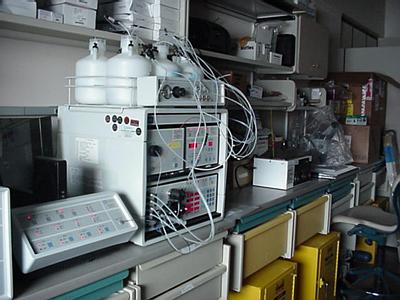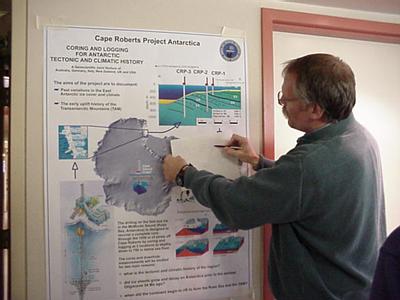26 November, 1999
Friday November 26, 1999
Got up at 0400 hours and went to check email. I was a bit disappointed that
not more people had sent holiday greetings. Oh well, such is life. There
were several notes from family and friends and some people had sent
electronic greeting cards. They were great, thanks.
Worked until 0930 then went to LTER lab, where Barb showed me her critters.
It is truly amazing that a thing that was a chunk of ice contained so much
and rather varied amounts of organisms. I was actually looking at the
primary consumers (all of which are microscopic) of the dry valley, namely
tartagrades, nematodes and rotifers . Unreal!
I used the bulk of the morning to isolate about 20 rotifers and about 10
nematodes. I have applied for a permit to bring samples home. I will
preserve them so there should be no problem with customs.
Barbara had also brought a DNA extraction kit from her school and she had
enough for me to attempt to extract DNA from several rotifers. I will not
be able to run these gels until I get home, so I'll have to wait to see if I
was successful.
This process took most of the afternoon.
On my way to my dorm I met a fellow (Richard ?) who I had sat near on the
plane. We traded war stories for about an hour then it was off to class.
Tonight Bruce Smith, one of the present TEA's from Wisconsin, had offered to
talk about the project he had worked on, The Cape Roberts drilling Project
(CRP). Bruce, besides being an outstanding scientist, and a marvelous and
dynamic teacher, is also an all around nice guy.
CRP is just finishing up its last year of about a $10,000,000 three year
drilling project. The major goals of the project were to look at why
Antarctica is so cold, much colder then its water-based counter part at the
other end of the world, the North Pole. The second goal being to look at and
better understand the events that took place during Antarctic history
through the late Cretaceous and early Cenozoic eras.
The drilling took place over three years. The drill rig itself is a
fifty-ton marvel. Because it had to drill through a layer of sea ice, then
travel through 300 meters of water and then into the ocean floor to a depth
of 1004 meters, the depth of the core this year, it had to be specially
designed. One of the major problems was holding all of the drill pipe in
place through the initial 300 meters of water. To counter the enormous
bulk, giant air filled balloons were used to enhance their buoyancy and air
bladders were suspended beneath the ice to help compensate for the 50+ tons
of drilling equipment.
Evidence suggests that the reason Antarctica is so cold, even compared with
the Arctic, is because there were/are ocean currents (Circum-Polar Currents)
and circumpolar winds that isolate the Southern Ocean, that which surrounds
the continent, from the rest of the world. These currents help/ed prevent
the mixing of the warmer waters of the rest of the world as occurs in a
place like Greenland. Much of Greenland is above the Arctic Circle, yet it
is influenced by the Gulf Stream which comes all to way to Greenland from
the Gulf of Mexico. No such happening in Antarctica.
These circumpolar winds help create a vortex (an atmospheric "plug") over
the continent which further keeps it isolated from warmer climates by
preventing even the winds from mixing. This isolation was even studied by
another group. This group demonstrated that at least 7 different varieties
of fish were isolated to this area, the so called the Southern Ocean, by
these circumpolar phenomena.
There has been much evidence produced here that shows Antarctica once, about
34,000,000 years ago, had a much warmer climate. This comes from the
geological analysis of the ice core and by looking at the biological
specimens that were found. The paleontologists and the calcarious
nanofossil people, those who look at microscopic fossils of the type similar
to those that make up the White Cliffs of Dover in England, are two groups.
The two other groups are the diatom people, those who look at the
diatomaceous earth, and the palynologists. Palynologists are the people
who study the organisms, unlike the calcareous and diatom critters which
have mineral shells, but that have organic coverings instead. These would
include dianoflagellates and spores. In fact, one of the palynologist found
a spore that was from a beech tree; beech trees are terrestrial organisms
that live in relatively warmer climates. This was an amazing and spectacular
find.
The explanation of why Antarctica was warmer back about 34,000,000 years ago
lies in the fact that at that time it was then part of the super-continent
Godwanaland. Because of this, there were no circumpolar winds and/or
currents that isolated it from the rest of the relatively mild world oceans
and atmosphere and there was a free exchange zone among all oceans and the
atmosphere as well.
It was not until New Zealand and Australia separated from this
super-continent and the circumpolar circulations came into existence; that
the area around Antarctica became isolated, began to cool off and then
became covered by glaciers..
The calarceous nonofossil, the palynologist and the diatom people stressed
that it is the microfossil and not the macro-fossil, dinosaurs, record that
contributes the most to stratigrahic dating. The reason for this being,
these smaller organisms mutate much quicker and when they are found in a
layer represent a smaller increment of time. Makes sense to me.
We actually got to pass through many of the CRP labs and met a number of the
researchers.
Following this tour Barb took some people to the computer room and I was
asked to show the rest of the group the rotifers and other critters that
Barb and I had found in the mat.
Following the class Barb and I stopped by a massive party that was
celebrating Thanksgiving among several dozen other happenings; e.g.
birthdays, anniversaries, etc. I stayed about 20 minutes and then went back
to my dorm to type. Went to midrats about 1230 hours and returned home about
0130 hours and went to bed.
Ciao,
Penguin Pete the Polar Man

This is the LTER lab that I work in at the Crary Laboratory. <> Photo by Peter M. Amati, Jr.

Mr. Bruce Smith, a TEA and a member of the Cape Roberts Drilling Project, explains his role in the research to a group of ASA parcticipants. Photo by Peter M. Amati, Jr. <>

NSF Science Representative Dr. Scott Borg stops by to give some additional background to Bruce's description of the Cape Roberts Project. Photo by Peter M. Amati, Jr. <>
Contact the TEA in the field at
.
If you cannot connect through your browser, copy the
TEA's e-mail address in the "To:" line of
your favorite e-mail package.
|
